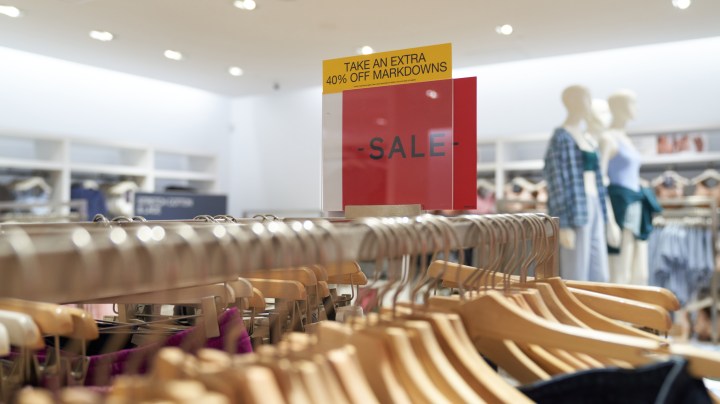
Deep discounts may move inventory, but at what cost?

A lot has changed in the retail economy since last Thanksgiving. Back then, supply chains were congested — 57 container ships backed up outside the Los Angeles and Long Beach ports. And retailers had trouble securing the inventory they needed to meet demand.
But today, there are zero ships backed up at those ports. And since we haven’t been buying as much stuff, retailers have too much inventory.
So, retailers have been using steep discounts to try to get rid of all the extra inventory they built up during the pandemic. But figuring out how much to mark down a product can be tricky.
Markdowns aren’t exactly ideal for retailers; discounts hurt profit margins at a time when retailers’ costs are rising. And if they cut prices too often, consumers might stop buying at regular prices, according to Christina Boni at Moody’s.
“You don’t want to train your customer to continually expect promotions,” she said.
Retailers can prevent that by offering promotions that only happen, say, once a year — like a Black Friday sale.
“That’s one way to clear out inventory and reduce price,” said Barbara Kahn, a professor of marketing at the Wharton School. “But it does seem like it’s not the real price — it’s only here for a special period of time.”
If those discounts are too steep or if they stick around for too long, Kahn said, consumers might start questioning a brand’s value.
“In the past, like the recession of 2009, when luxury brands did deep discounts because they mispredicted their holiday sales there, that took them a long time to bring back the value to the brand.”
And if one retailer offers a discount, others might feel the need to match that price. Retailers might then go to the brand manufacturers and start demanding that they charge lower prices, per Sucharita Kodali, a retail analyst at Forrester Research.
“Saying, ‘Hey, you’re allowing this kind of, this type of crazy pricing to happen, so you need to give us lower prices so we can at least break even or make a profit,'” Kodali said.
Manufacturers can try to prevent this from happening with minimum price agreements, Kodali said. These are common in high-end electronics like phones or TVs, but less so with cheaper goods you might find at a big-box store.
“It’s very hard when you’re a mass consumer packaged-goods brand that sells toothpaste to be able to do that because you just need as much distribution as you can get,” she said.
Most manufacturers would have a hard time enforcing a minimum price, Kodali added. That means their margins are likely to take a hit as well if retailers keep discounting products into next year.
There’s a lot happening in the world. Through it all, Marketplace is here for you.
You rely on Marketplace to break down the world’s events and tell you how it affects you in a fact-based, approachable way. We rely on your financial support to keep making that possible.
Your donation today powers the independent journalism that you rely on. For just $5/month, you can help sustain Marketplace so we can keep reporting on the things that matter to you.

















